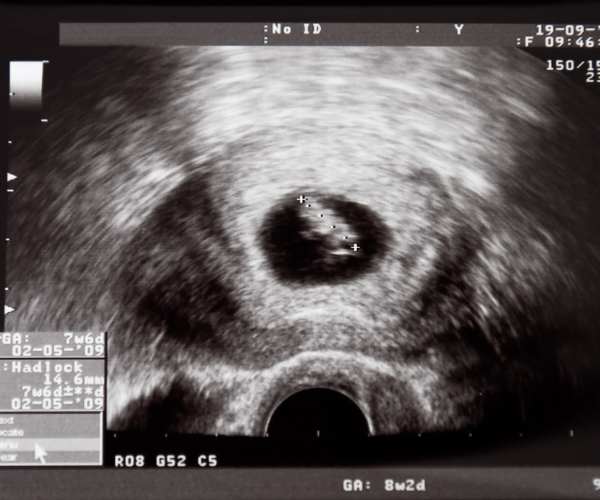Further Information about the Stages of Pregnancy
Every pregnancy is divided into three periods called trimesters, and this article will help you understand what happens during this period.
First Trimester (Weeks 1-12)
What are the signs of pregnancy in the first weeks?
In the first trimester, which is the first 12 weeks of pregnancy, most women complain of the following signs of pregnancy. These symptoms may include:
- Nausea: Even though it is known as morning sickness, nausea can happen at any time of the day. It is estimated that 7–8 out of 10 women experience nausea, with onset commonly in the 6th week of pregnancy, and it can persist until the end of the first trimester.
- Fatigue: Fatigue is also a very frequent complaint during this period. According to research, about 58 percent of women reported that they felt more tired than usual due to hormonal changes, especially the high level of progesterone.
- Hormonal Changes: Your body is filled with hormones that are required to support the pregnancy, including hCG and progesterone. These changes in hormones cause most of the physical and emotional changes you may experience.

Why is it crucial to have prenatal appointments during this time?
It is recommended that you attend prenatal appointments and undergo tests in the first trimester to assess your and your baby’s health. The American College of Obstetricians and Gynecologists (ACOG) advises that your first prenatal visit should be set as soon as you think you are pregnant or, at the latest, by week eight of pregnancy.
During these visits, your healthcare provider will:
- Order blood tests for hormones, blood type, and for other disorders including anemia or infection.
- Schedule an appointment for an ultrasound to confirm the pregnancy and to determine how many weeks you are along.
Being proactive about your health means that any conditions that could lead to problems like ectopic pregnancy or miscarriage are caught and treated in time.
What happens to your body?
When the fertilized egg begins to nest in the uterus, your body goes through many changes. The development of the embryo is rapid; by the end of one month, it measures about 1 inch and is the size of a lime. This is the most important stage in the development of organs such as the heart, brain, and digestive system.
Second Trimester: Weeks 13 – 26
Why is the second trimester usually more comfortable?
The second trimester (weeks 13 to 26) is usually the best for many women since the most uncomfortable symptoms of pregnancy are now over. Some of the most uncomfortable symptoms of the first three months, including nausea and fatigue, may lessen or disappear, making you feel more energetic.
What other symptoms are experienced by women during this time of pregnancy?
Some common pregnancy symptoms in this trimester include:
- Leg cramps: About one in three pregnant women complains of having leg cramps, most often at night. These are usually blamed on changes in circulation and increased pressure on the legs from the developing fetus.
- Breast tenderness: Your body remains full of hormonal changes that make your breasts feel more sensitive and fuller than before.
When is the right time to know the gender of the baby?
The anatomy ultrasound, done between 18 and 20 weeks, is when most people learn whether they are having a boy or girl. This time frees people and can also be a stimulus to prepare for the birth of the child.
Third Trimester (Weeks 27-40)
What should you know when you are preparing for labor?
The third trimester begins from week 27 to week 40, and the body is in preparation for labor. Signs to watch for include:
- Braxton Hicks contractions: These contractions can start from the second trimester but are more noticeable in the third trimester. They assist in making the uterus ready for the real action of delivery.
What ways can you talk to your doctor or midwife about the options available for birth?
This is the best time to address the issue of how you want to deliver your baby. Your healthcare provider will help you understand the pros and cons of different methods of delivery, including:
- Natural birth: This approach does not involve the use of drugs; the person involved is required to use breathing exercises and have a partner present.
- Epidural: It is given through an injection at the back and is useful during delivery. It may assist many women in overcoming the pain caused by contractions.
- C-section: Sometimes, a cesarean section is required when there is a problem, the baby is in a breech position, or for other reasons. About one-third of babies in the United States are born through cesarean section.
Why is it necessary to track weight gain and health?
It is crucial to watch your weight and your health as you near your delivery date. The Institute of Medicine provides guidelines on weight gain during pregnancy, which vary based on your pre-pregnancy weight:
- Underweight women (BMI < 18.5): Gain 28-40 pounds.
- Normal weight women (BMI 18.5-24.9): Gain 25-35 pounds.
- Overweight women (BMI 25-29.9): Gain 15-25 pounds.
- Obese women (BMI ≥ 30): Gain 11-20 pounds.
Eating a nutritious diet will help your baby develop and prepare your body for labor and birth.
Specialties of Each Week
Week 1-4
When can one begin to notice pregnancy?
In the first four weeks of pregnancy, most women may experience some symptoms. The most common indicators include:
- Missed Menstrual Period: Approximately 29 percent of women say this is their first sign.
- Increased Fatigue: About 60% of women suffer from severe fatigue at this time as the level of progesterone increases.
- Frequent Urination: This occurs because, as the levels of hCG (human chorionic gonadotropin) rise, women may need to make frequent visits to the bathroom.
What is the procedure of implantation?
The implantation process is when the fertilized egg buries itself into the endometrium. This critical stage usually occurs around days six to ten post-conception. Your body begins to nurture the developing embryo by:
- Improving the supply of blood in the uterus to enhance nutrient delivery.
- Releasing hormones that instruct the body to continue with the pregnancy.
Week 5-8
What changes does the embryo go through during these weeks?
From the fifth to eighth week, the embryo’s growth is rapid. Significant milestones include:
- Major Organ Formation: By the end of this period, the heart, lungs, and digestive system can be identified. By the sixth week, the embryo is slightly smaller than a pea.
What are the signs of early pregnancy?
Many women report experiencing early pregnancy symptoms during this time, such as:
- Bloating: This occurs in about half to three-quarters of women and can be attributed to hormonal changes.
- Mood Swings: Hormonal changes cause mood swings affecting approximately 70 percent of women.
Week 9-12
What has happened by the first trimester of pregnancy?
At the beginning of the second month (12 weeks), your baby is about the size of a lime. All major organs are developed and start functioning.
What should you expect during the very first ultrasound?
Your doctor may perform your first ultrasound at this time to evaluate the growth of your baby. Key points include:
- Confirming the due date: Generally, ultrasounds are accurate within +/- 1-2 weeks.
- Checking for multiple pregnancies: This is when you may find out you are having twins or even more than two babies.
Week 13-16
What can you expect in the second trimester?
During weeks 13 to 16, many women notice the following changes:
- Baby’s Growth: The baby continues to grow, and you may begin to show more.
- Reduced Symptoms: Discomforts such as nausea often significantly decrease, providing relief.
What are some common symptoms during this period?
Common symptoms in this phase can include:
- Increased Appetite: As nausea subsides, many women find their appetites return, and it’s crucial to focus on nutritious foods.
- Round Ligament Pain: As the uterus expands, some women may experience discomfort in the lower abdomen due to stretching ligaments.
What Happens as You Reach the Second Trimester?
During the second trimester of your pregnancy, which is between weeks 13 and 16, the energy levels of many women rise. You can start to develop a baby bump as your baby develops, and your belly will start to pop out.
What is the Need of a Balanced Diet?
Describing the significance of the proper diet in this period is crucial. Nutritional needs increase with the following guidelines:
Increase in Calorie Intake
A pregnant woman should consume 300-500 calories more than usual while making sure that she chooses the right foods to eat.
Key Nutrients
Micronutrients, which are vital for your baby, are folic acid, iron, calcium, and proteins.
Week 17-20
What Major Event Happens at This Time?
In the period between the 17th and the 20th week of pregnancy, many women are able to feel their baby’s movements for the first time, a process called quickening. This is likely to occur between 18 and 20 weeks of the pregnancy and may be described as a feeling of flutters or bubbles.
What Should You Do Before Your Baby Comes?
This is an excellent opportunity to set up profiles for your baby’s nursery and get the basics. Consider:
- Baby Registry: Begin to gather items you will need like clothing, diapers, and baby furniture, bedding, toys, etc.
- Decorating the Nursery: Select a theme or color that you prefer and that will help you design a comfortable corner for your baby.
Week 21-24
What Kind of Changes Are You Likely to See?
In weeks 21 to 24, dealing with the physical changes is vital as the body grows in size. Common changes include:
- Back Pain: About half of all pregnant women complain of back pain owing to the extra weight being carried, as well as hormonal changes that soften joint ligaments.
- Skin Changes: Most women experience some degree of skin changes such as stretch marks or melasma, which is also known as the “pregnancy mask.”
What Can You Gain from Having Regular Check-Ups?
It is also important to visit your healthcare provider from time to time to have checkups on blood pressure and the baby. These visits often include:
- Fetal Heart Rate Monitoring: Feeling your baby’s pulse; it should be between 120 to 160 beats per minute at this age.
- Blood Pressure Checks: Tracking your blood pressure makes it easier to notice if there is a problem like gestational hypertension.
Week 25-28
What is the Nesting Instinct?
In the last four weeks of pregnancy, that is from the 25th week to the 28th week, many women get what is commonly known as the nesting urge. This can include:
- Cleaning and Organizing: A lot of women begin cleaning the house thoroughly and organizing the nursery room.
- Gathering Supplies: Start assembling items like clothes for the baby, diapers, baby food, and other baby needs.
What Makes it Necessary to Discuss Labor Signs?
It is quite useful to mention the signs of labor and know how to approach pain during delivery. Key signs to recognize include:
- Contractions: Find out the difference between Braxton Hicks contractions and real labor contractions.
- Water Breaking: It is important for a woman to know the time and way to identify the onset and signs of her water breaking.
Week 29-32
Possible Feelings a Couple Might Experience in This Stage
In weeks 29 to 32, the emotional changes may start to increase. Stress and emotional well-being become more important as you enter this fun and often stressful period. Techniques to consider include:
- Mindfulness and Relaxation Exercises: Meditation or practicing yoga can be very useful to relieve stress and improve the mood and emotional state of people.
- Support Systems: It is also helpful to be with friends, family, or support groups to avoid excessive worrying.
Which Baby Milestones Should You Monitor?
During this stage, keep track of baby milestones, such as:
- Developing Brain Activity: The baby’s brain is still growing with the enhanced connection between neurons.
- Lung Maturity: At this time, the baby’s lungs are forming surfactant, which is used to breathe after birth.
Week 33-36
What Signs of Labor Should You Know?
As you approach weeks 33 to 36, it’s crucial to learn the signs of labor, which include:
- Contractions: Here the timing and intensity of contractions have to be observed. Original contractions are said to become more frequent and intense over time.
- Changes in Vaginal Discharge: Look for bright red bleeding or an increase in discharge, which may indicate the onset of labor.
- Mucus Plug: The mucus plug is a part of the body that signals the start of labor; however, labor may not begin immediately and may take days or even weeks.
Which Medical Appointments Are Required During This Time?
This phase can require frequent visits to your doctor for follow-up checks. Typical assessments include:
- Pelvic Exams: Going to see your doctor to check how dilated and thinned out your cervix is as your delivery date approaches.
- Fetal Monitoring: Maintaining fetal heart rate and their movements to ensure they are standard.
Week 37-40
What Should You Do When You Are in Your Last Weeks of Pregnancy?
In the last month of your pregnancy, from weeks 37 to 40, it is time to pack your own and your baby’s hospital bag. Consider including:
- Comfort Items: Some of the things that you can bring include a pillow, slippers, and snacks.
- Documents: Check that you have necessary documents, such as the birth plan, insurance details, and ID.
What Do You Need to Look Forward To? What Should You Reflect On?
This is a time of hope and waiting to meet your baby and become a parent. Take the time to:
- Connect with Your Partner: Explain what you want to happen during the birth and the things that you would like the doctor to do or not to do.
- Celebrate the Journey: Look at how your body has changed and at the new life that is waiting for you.
What Measures Can I Take to Overcome Some of the Symptoms of Pregnancy?
Symptoms of pregnancy can be self-regulated through changes in diet and exercise and natural treatment alongside the help of doctors. For example, fatigue can be managed by ensuring that one is well rested and even taking short naps in between work. It’s also important to stay hydrated; the lack of water can worsen the state of fatigue since dehydration is a common cause of it. Additionally, making sure that one takes enough food that contains iron and proteins is crucial.
To prevent nausea, especially morning sickness, taking small portions of food several times a day is recommended. Ginger tea and crackers might help with nausea, as a study in the American Journal of Obstetrics and Gynecology revealed that ginger can lessen nausea in about 70% of patients.
Frequent urination may not be easy to control, but having a timetable for bathroom use and doing pelvic floor exercises can be helpful. It is also advisable to stop taking any form of beverage containing caffeine and spicy foods, as they can stimulate the bladder.
Symptoms that become severe or hard to cope with should be discussed with a doctor. They can provide specific advice on what the patient should do or prescribe medication that is safe to take during pregnancy.
What Do I Need to Put in My Birth Plan?
Many-to-be parents find it useful to create a birth plan. Key components to include are:
Preferences for Labor and Delivery
Express your wishes regarding the types of positions during labor, forms of pain relief (e.g., whether an epidural is allowed, if you want to use gas, etc.), and which medical interventions you do and do not want under any circumstances.
Support System
Identify who may be allowed to attend the labor and delivery. This may include partners, family members, or doulas.
Postpartum Preferences
Include details on postpartum care options, such as holding the baby immediately after delivery and feeding options.
Newborn Care
You may wish to express preferences about what should happen to your baby immediately after birth, for example, regarding vaccinations or procedures.
According to the American Journal of Obstetrics and Gynecology, preparation and communication can help improve your birth experience as you explain your birth plan to your healthcare provider.
What Are Some Myths About Pregnancy?
There are many myths of pregnancy that may cause confusion or stress for women. Here are a few debunked myths:
Eating for Two
Unfortunately, the myth that pregnant individuals should consume twice the amount of food they normally eat is widespread. In fact, they require about 300 more calories in the second and third trimesters, not the 500 that many people think.
Avoiding Exercise
It is widely thought that all forms of physical activity should be avoided during pregnancy. However, regular moderate exercise can help improve health and lessen the effects of disease. The American Pregnancy Association suggests that a woman should do at least 30 minutes of moderate exercise on most days of the week unless her doctor has advised otherwise.
Cravings Mean Deficiencies
Cravings during pregnancy are very common and do not always indicate that a woman needs specific nutrients. Most of the time, they are caused by hormonal fluctuations.
Heartburn is a Sign of a Hairy Baby
This myth has no scientific basis; heartburn results from hormonal changes and pressure of the uterus on the stomach.
Knowing what really happens during pregnancy will go a long way in allaying fears and making expectant parents well-prepared.
What Are the Ways to Achieve Emotional Stability During Pregnancy?
It is important for a woman to be emotionally stable and strong during this period to ensure physical well-being as well. Mood swings are another common side effect of hormonal changes; that is why having people around is essential. Here are several strategies:
Open Communication
Share emotions with partners and friends on a daily basis. Interacting with others can help reduce feelings of loneliness.
Mindfulness Practices
Some stress-relieving measures include meditation, yoga, and deep breathing. According to a study conducted by The Journal of Perinatal Education, mindfulness practices help decrease anxiety levels and enhance the mood of pregnant individuals.
Seek Professional Help
Consulting with a therapist or counselor who focuses on prenatal care can provide an outlet to discuss feelings and cope with symptoms.
Join Support Groups
Support groups for expectant parents can help individuals feel they are not alone. Many hospitals and local healthcare providers offer support groups.
Conclusion
Every woman is different; it is important to accept the physical and emotional changes that occur during pregnancy, labor, and delivery. Expecting parents should communicate with one another and provide support during this exciting time. Please feel free to post your own experiences and questions in the comments below; we would appreciate it!






